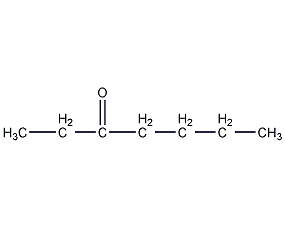
Structural formula
| Business number | 02T7 |
|---|---|
| Molecular formula | C7H14O |
| Molecular weight | 114.19 |
| label |
3-Heptanone, Ethyl n-butyl ketone, Ethyl butyl ketone, Ethyl n-butyl (methyl) ketone, 3-Hydroxyheptane, butyl ethyl ketone, n-butylethyl ketone, butyl ethyl ketone, 3-Heptanone, Heptan-3-One, Ethyl Butyl Ketone, Ethyl n-Butyl Ketone, Butyl Ethyl Ketone, n-Butyl Ethyl Ketone, high boiling point solvents, Dispersants for organosols |
Numbering system
CAS number:106-35-4
MDL number:MFCD00009483
EINECS number:203-388-1
RTECS number:MJ5250000
BRN number:506161
PubChem ID:None
Physical property data
1. Properties: colorless liquid with acetone-like odor. [1]
2. Melting point (℃): -39[2]
3. Boiling point (℃): 147.3[3]
4. Relative density (water = 1): 0.82[4]
5. Relative vapor Density (air=1): 3.93[5]
6. Saturated vapor pressure (kPa): 0.187 (25℃)[6]
7. Critical pressure (MPa): 2.92[7]
8. Octanol/water partition coefficient: 1.73[8]
9. Flash point (℃): 46 (OC) [9]
10. Ignition temperature (℃): 410[10]
11. Explosion upper limit (%): 8.8[11]
12. Explosion lower limit (%): 1.4 [12]
13. Solubility: soluble in water, soluble in ethanol and ether. [13]
14. Relative density (20℃, 4℃): 0.818
15. Relative density (25℃, 4℃): 0.814
16. Refractive index at room temperature (n25): 1.4066
17. Critical volume (cm3·mol-1): 433
18. Critical density (g·cm-3): 0.264
19. Viscosity (mPa· s, 20ºC): 0.76
20. Volume expansion coefficient (K-1, 20ºC): 0.00106
Toxicological data
1. Skin/eye irritation
Open irritation test: rabbit, skin contact: 500mg, severity of reaction: mild.
Standard Draize test: rabbit, skin contact: 500mg/24H, severity of reaction: moderate.
Standard Draize test: Rabbit, Eye contact: 100mg, Severity of reaction: Mild.
Standard Draize test: Rabbit, eye contact: 500mg/24H, severity of reaction: mild.
2. Acute toxicity: rat oral LD50: 2761mg/kg; mouse inhalation LCLo: 2000ppm/4H; rabbit skin contact LD50: >20mL/kg;
3. Vapor effects on It is irritating to the eyes and skin and mucous membranes, and has a degreasing effect on the skin. Long-term exposure can cause dermatitis. The maximum allowable concentration in the workplace is 230mg/m3.
4. Acute toxicity[14] LD50: 2760mg/kg (rat oral)
5. Irritation[15]
Rabbit transdermal: 500mg (24h), severe irritation .
Rabbit eye: 100mg, mild irritation.
Ecological data
1. Ecotoxicity No data available
2. Biodegradability No data available
3 .Non-biodegradability[16] In the air, when the concentration of hydroxyl radicals is 5.00×105/cm3, the degradation half-life is 2d (theoretical).
4. Other harmful effects[17] This substance may be harmful to the environment , special attention should be paid to water bodies.
Molecular structure data
1. Molar refractive index: 34.50
2. Molar volume (cm3/mol): 141.2
3. Isotonic specific volume (90.2K ): 315.7
4. Surface tension (dyne/cm): 24.9
5. Polarizability: 13.68
Compute chemical data
1. Reference value for hydrophobic parameter calculation (XlogP): 1.8
2. Number of hydrogen bond donors: 0
3. Number of hydrogen bond acceptors: 1
4. Number of rotatable chemical bonds: 4
5. Number of tautomers: 3
6. Topological molecule polar surface area 17.1
7. Number of heavy atoms: 8
8. Surface charge: 0
9. Complexity: 66.8
10. Number of isotope atoms: 0
11. Determine the number of atomic stereocenters: 0
12. Uncertain number of atomic stereocenters: 0
13. Determine the number of chemical bond stereocenters: 0
14. Number of uncertain chemical bond stereocenters: 0
15. Number of covalent bond units: 1
Properties and stability
1. Stability[18] Stable
2. Incompatible substances[19] Strong oxidizing agent, strong reducing agent, strong alkali
3. Polymerization hazard[20] No polymerization
Storage method
Storage Precautions[21] Stored in a cool, ventilated warehouse. The storage temperature should not exceed 37°C. Keep away from fire and heat sources. Keep container tightly sealed. They should be stored separately from oxidants, reducing agents and alkalis, and avoid mixed storage. Use explosion-proof lighting and ventilation facilities. It is prohibited to use mechanical equipment and tools that are prone to sparks. The storage area should be equipped with emergency release equipment and suitable containment materials.
Synthesis method
It is obtained by heating 3-heptanol and air to 300°C through a silver mesh.
Purpose
1. It is a stable high-boiling point solvent. It is used as a solvent for nitrocellulose. It is also used in organic synthesis. It is also used as a dispersant for preparing mixed solvents and organosols.
2. Used as a dispersant for preparing mixed solvents and organosols. [22]

 微信扫一扫打赏
微信扫一扫打赏

